

The seven traits of effective digital enterprises. The age of experimentation with digital is over.
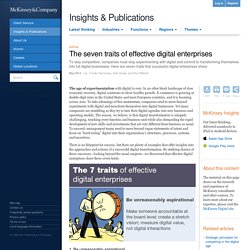
In an often bleak landscape of slow economic recovery, digital continues to show healthy growth. E-commerce is growing at double-digit rates in the United States and most European countries, and it is booming across Asia. To take advantage of this momentum, companies need to move beyond experiments with digital and transform themselves into digital businesses. Yet many companies are stumbling as they try to turn their digital agendas into new business and operating models. The reason, we believe, is that digital transformation is uniquely challenging, touching every function and business unit while also demanding the rapid development of new skills and investments that are very different from business as usual.
There is no blueprint for success, but there are plenty of examples that offer insights into the approaches and actions of a successful digital transformation. 1. 2. Doing the Internet of Things right! How an enterprise begins its big data journey. As the amount of data continues to double in size every two years, organizations are struggling more than ever before to manage, ingest, store, process, transform, and analyze massive data sets.

It has become clear that getting started on the road to using data successfully can be a difficult task, especially with a growing number of new data sources, demands for fresher data, and the need for increased processing capacity. In order to advance operational efficiencies and drive business growth, however, organizations must address and overcome these challenges. The Big Data Market: 2015 - 2030 - Opportunities, Challenges, Strategies, Industry... NEW YORK, July 21, 2015 /PRNewswire/ -- "Big Data" originally emerged as a term to describe datasets whose size is beyond the ability of traditional databases to capture, store, manage and analyze.

However, the scope of the term has significantly expanded over the years. How data changes the natural resources game. Mining has a lot of useful chaos – the means to shape that resides in big data and the Internet of Things.

(Image Source: pnrsoftsol.com) Mining is a challenging and forever evolving business, one tied to numerous internal and external forces. This could be said for many business sectors, but mining’s particular financial girth makes it stand out. It’s an industry that generates capital so large it can determine the health of country GDPs – in 2014, the top ten mining companies globally had shared revenues of nearly half a trillion dollars, and that was a bad year. In gambling parlance, mining is a high roller, a suitable definition considering the industry’s volatile nature. PWC’s Mine 2014: Realigning Expectations lays that volatility bare: last year, the market capitalisation of the top 40 mining firms dropped by twenty three percent – an incredible $280 billion. How big data analytics help hospitals stop a killer. Big data.
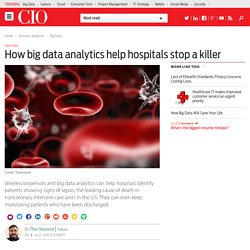
Predictive analytics. Real-time. Actionable insight. There's a buzzword smorgasbord around the use of data to derive value. It doesn't help that sometimes the benefits can be esoteric, or at least hard to visualize. Sepsis is a serious medical condition that occurs when the body unleashes the full force of the immune system in response to an infection. According to the National Institute of General Medical Sciences, more than a million Americans get severe sepsis every year and between 28 percent and 50 percent of them die — more than the annual U.S. deaths from prostate cancer, breast cancer and AIDs combined. Leveraging data for the digital age. Today in Singapore, every business is becoming a digital business, from pure online entities to traditional companies embracing mobile, social and cloud platforms.
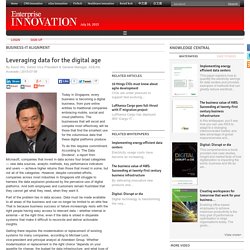
The businesses that will excel and compete most effectively will be those that find the smartest use for the voluminous data that these digital platforms produce. To do this requires commitment. Gartner: Big Data’s 10 Biggest Vision and Strategy Questions. Cutting cost and power consumption for big data. Random-access memory, or RAM, is where computers like to store the data they’re working on.
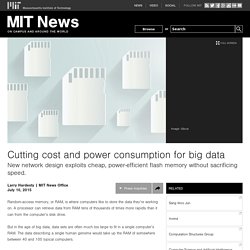
Big data analytics accelerates Williams' Formula One performance - IT Feature from V3.co.uk. Formula One cars are essentially big data factories on wheels.
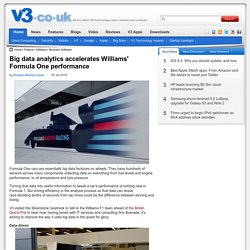
They have hundreds of sensors across many components collecting data on everything from fuel levels and engine performance, to oil temperature and tyre pressure. Turning that data into useful information to tweak a car's performance is nothing new in Formula 1. But driving efficiency in the analysis process so that data can shave race-deciding tenths of seconds from lap times could be the difference between winning and losing. V3 visited the Silverstone racetrack to talk to the Williams F1 team ahead of the British Grand Prix to hear how, having joined with IT services and consulting firm Avanade, it's aiming to improve the way it uses big data in the quest for glory.
Data driven Big data collected from F1 cars is vital for maximising performance. Data collected and analysed during wind tunnel testing is also used to fine tune the aerodynamics of the car to extract the best performance within F1 regulations. What Do I Do With My Data? Part 1: Don't Use A Technology Band-Aid While kicking off a project last October, a client showed us slide after slide of reports, architectures, and data flows.

Overwhelmed by information, the client looked at us and asked – what do I do with all this data? A plea for help I have heard on almost every engagement since. Due to this trend, I am starting a blog series answering the question from a multitude of perspectives. Tim Hughes sur Twitter : "Gartner: By 2017, 30% of enterprise access to #bigdata will be via data broker services, serving context to decisions.
Microsoft Developer sur Twitter : "#Build2015: Announcing #SQL Data Warehouse - a data warehouse that can power up in seconds. #BigData. What Big Data Means for the Legal System - The Experts. World Bank sur Twitter : "How can #bigdata help solve tough challenges? Learn more April 15, 1pm ET: Big Data for a More Resilient Future. Follow the event on Twitter by using #BigData Date: Wednesday, April 15, 2015Time: 1:00 p.m. - 2:30 p.m.
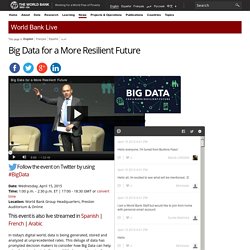
ET | 17:00 - 18:30 GMT or convert timeLocation: World Bank Group Headquarters, Preston Auditorium & Online This event is also live streamed in Spanish | French | Arabic. The First Prime Minister to Use Big Data. Twitter. Driving Innovation with big data. The history of innovation is scattered with products and processes which only came into being as a result of an accident or pure serendipity.
Microwave ovens, X-ray machines, penicillin, Play-Doh – to name a few – all came about not as a result of being designed from a blank sheet of paper, but by innovators who had the vision and motivation to seek wider applications for what was there in front of them. This is equally true in the digital world, where technological development relies so much on lateral vision and having a wider perspective on the potential uses of existing technology and information.
Computers may soon know you better than your spouse. By analysing someone's likes on Facebook, statistical modeling software could characterise a person's basic personality with an accuracy rivaling that of a spouse or close family member. How good are you at sizing someone up? Perhaps not as good as a computer, according to researchers at the University of Cambridge and Stanford University. By analysing someone's likes on Facebook, statistical modeling software could characterise a person's basic personality with an accuracy rivaling that of a spouse or close family member, according to the researchers. Analysing such digital footprints could help computer programs to interact with people in more meaningful ways, according to the scientists, whose findings were published Monday in the Proceedings of the National Academy of Sciences. Although big data systems already help to analyse human behavior, particularly around buying habits, today's statistical modeling techniques tend to be very narrow in scope.
Data Architecture: A Primer for the Data Scientist: Big Data, Data Warehouse ... - W.H. Inmon, Dan Linstedt - Google Books. Analytics and investment management: Turning big data into business intelligence. Information Rich, Knowledge Poor: Overcoming Insurers’ Data Conundrum. Stop using the term "big data" One finding has been common in all the research I’ve done on big data over the last few years: Nobody likes the term. Many think it’s an important concept, and some think it’s revolutionary, but almost everybody wishes for a better, more descriptive name for it.
Some managers are objecting only to the hype around the big data buzzword, but I believe many executives simply yearn for a better way to communicate what they are doing with data and analytics. Part of the problem is that “big data” just doesn’t describe the phenomenon very effectively. Here are several reasons why the term is highly flawed: The term “big” is obviously relative—what’s big today won’t be so large tomorrow. For these reasons, and perhaps others, the term just doesn’t suit.
So why don’t we simply stop using it? What to call this phenomenon probably isn’t your company’s most important problem now. Two dogmas of big data: Understanding the power of analytics for predicting human behavior - Deloitte University Press. “Society became statistical. A new type of law came into being, analogous to the laws of nature, but pertaining to people. These new laws were expressed in terms of probability.” —Ian Hacking Predicting the present Roughly ten years ago, The Economist magazine quoted the science fiction author William Gibson as saying, “The future is already here—it’s just not very evenly distributed.”1 Gibson’s comment is not a bad description of the varying degrees to which analytics and data-driven decision-making have been adopted in the public and private spheres.
Issue 15 » Periodicals. Six trends in the big data revolution: expanding definitions of health, medicine, and health care - A view from the Center. Big data revolution: Part 5 of a 6-part series by Dan Housman. Director, Deloitte Consulting LLP and Chief Technology Officer of ConvergeHEALTH In 1991 the phrase “perfect storm” was made popular by the movie of the same name when the Andrea Gail was caught in theconfluence of two powerful weather fronts and a hurricane. The phrase describes the phenomenon where the powerful combined effect of a unique set of circumstances results in enormous impact. AN ARTICLE FOR YOU.
Rely on transaction data to settle financial contracts: Reserve Bank of India. When Big Data and the Internet of Things Collide. Hadoop, Business Analytics and Beyond.